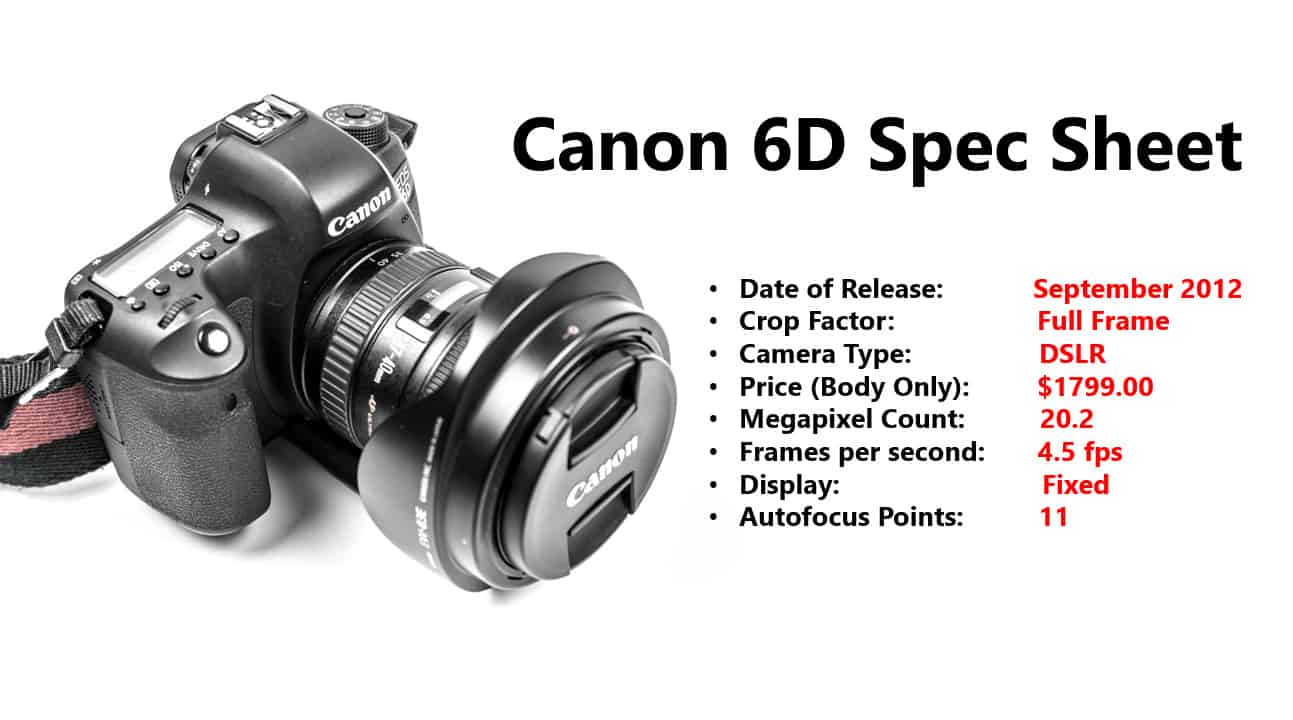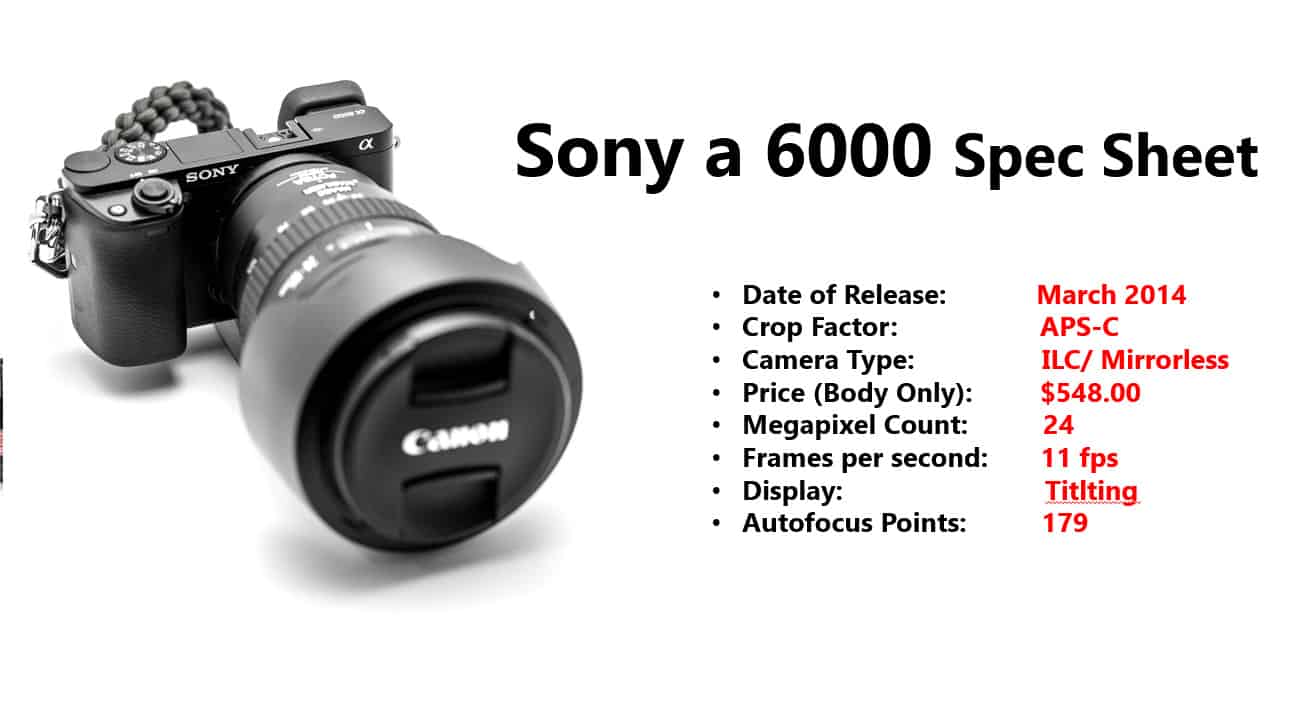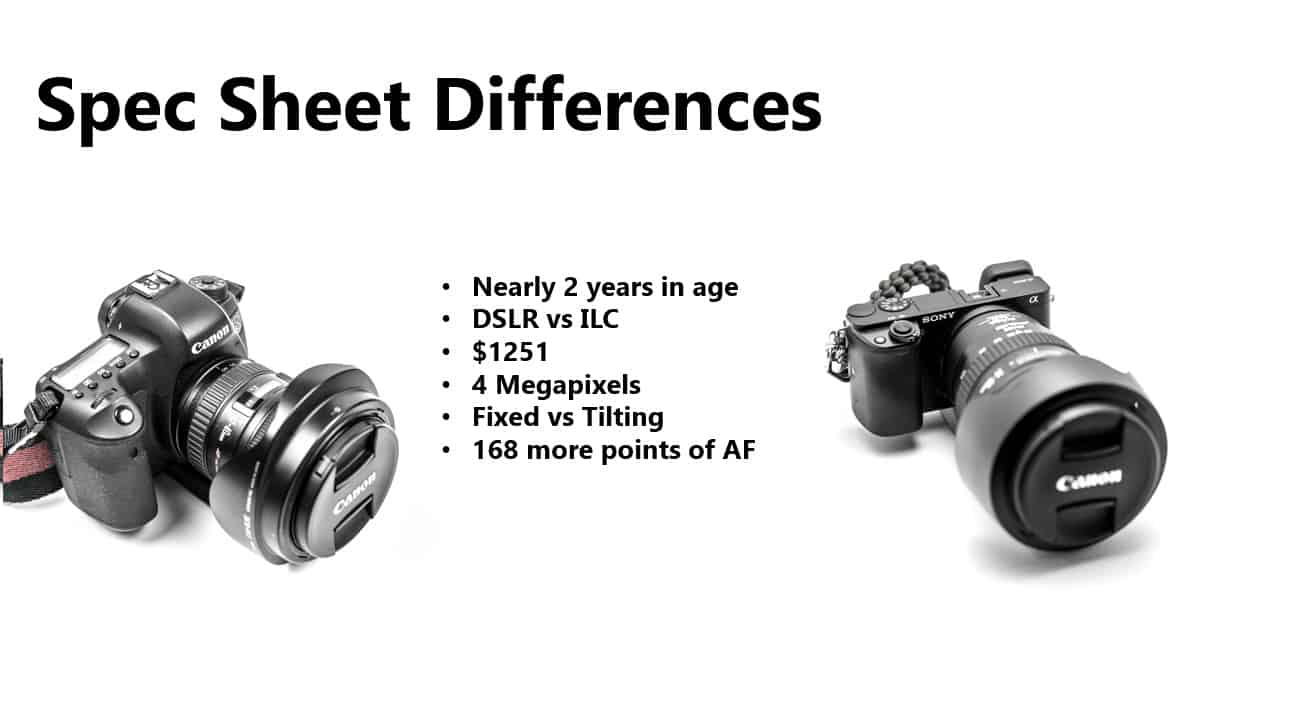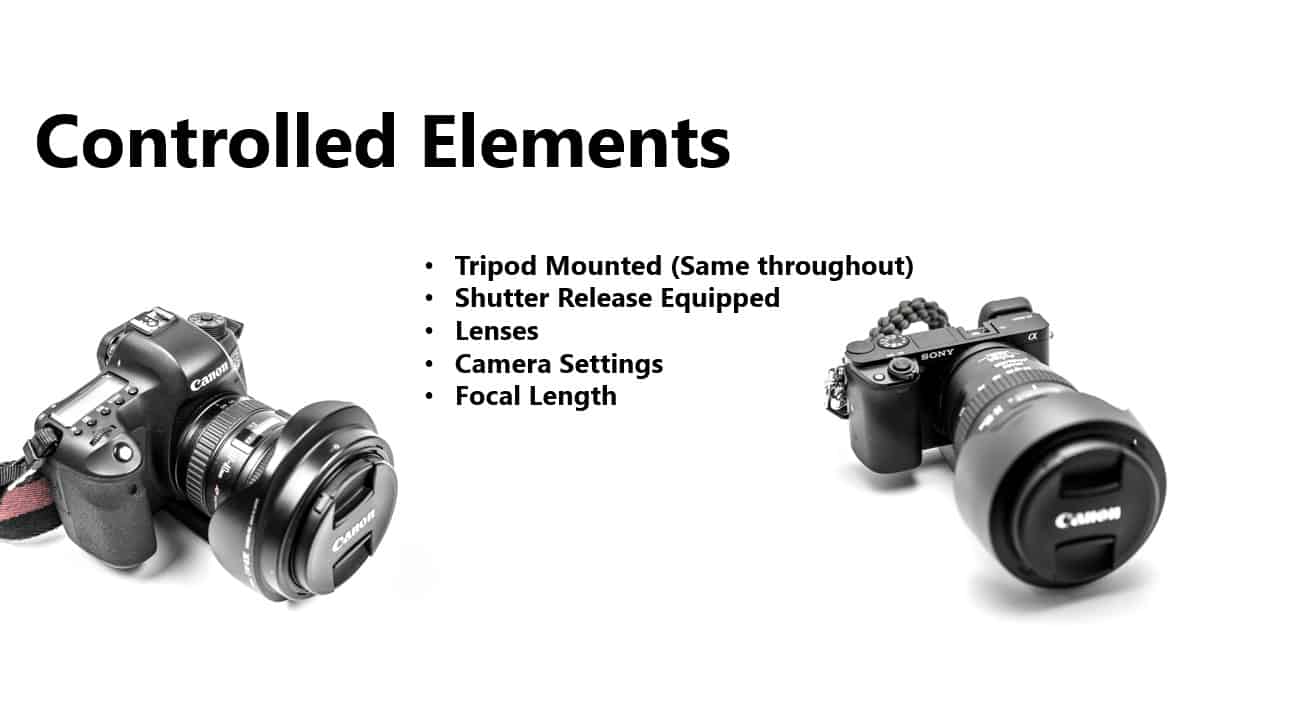One Epic Battle!
I have owned the Canon 6D for quite sometime now and have loved it since day 1!
We really are two peas in a pod at times. We share everything from our thoughts on priorities, like Aperture to Cropping in public. It really has been a match made in heaven.
Then along came the a6000, a slimmer-younger bodied camera with assets that make an experienced photographer drool!
All jokes aside! Both of these cameras are phenomenal. They boast many incredible features that are perfect for any landscape photographer and are almost identical in quality. However, one is nearly ~$1200 less than the other.
There are all kinds of videos circling YouTube that show the a6000 “destroying” the 5D Mk III and the Canon 6D. I didn’t believe them when I saw them so I ran my own set of tests.
Below are the Spec Sheets for both cameras along with the differences and some of the ways I controlled my experiments.
In this tutorial/battle I will put both cameras side by side in a series of field tests that will compare the following:
- The affects of Crop Factor
- ISO handling
- Long Exposure
- HDR
- DP Review Reports
Like the style of this tutorial? You will LOVE HDR Insider! Full-Length HDR Workflows, Critiques & More!
[hcshort id=”5″]














Great review as that I own both camera’s. Why you are using the back wheel to adjust your stops I don’t know. Set your A6000 up that you use the top wheel. Do it all the time. On the same note make sure you turn on Zebra and see how that inter acts with your stops. Think you are going to love it….
Thanks for the tips Gord. In Manual Mode the top wheel adjusts the Apertures and the lower wheel adjusts the Shutter Speed, that was my frustration. I did end up turning the left, right, and down buttons off so they don’t go to anything anymore. That helps a ton, but I had to figure that one out on my own. Now I just use the quick menu to change those settings instead of the directional arrows. I have the Zebras on also, that does help. I love how fast the shutter is on that camera. Handholding for HDR is NO problemo!
I have arrived at a similar place rom a different perspective. I do a lot of wildlife/bird photography. There is just no substitute for my full frame Nikon equipment and a 500-600mm lens. Nikon’s video, however, doesn’t begin to compare to what I get from my Lumix GH4 and because of it’s crop factor (2), I can get very decent wildlife video. On a recent trip to Tuscany, where each included a huge amount of walking, I found myself carrying the GH4 and two lenses instead of my much heavier D800. The GH4 is not only smaller and lighter, but so are its lenses, and it’s image quality is superb. The low light capabilities of the D800 are better; wide angle options are better. My 16-35 Nikon lens takes wonderful images, but it weighs about as much as the GH4 with a lens and is a big, heavy chunk of glass to carry all day compared with a mirrorless camera. I doubt that I’ll ever purchase another DSLR
Thanks for sharing your mirrorless experience. I think I may be in the same boat as you. I love my Canon 6D, I waited a very long time before I dove into full frame and spent a lot of time with sub standard equipment until the time for me to switch was perfect. I think I may do the same here. I am at odds though, with the Fotga Adapter on the a7r, I could upgrade the Canon pretty easily and still have access to all of my glass. IT is a tough decision, but I think I may end up waiting. I have spent the bulk of the morning researching the a7r and a7ii and just need to stop looking!!!
I forgot to add, regarding the Lumix GH4 versus my Nikon equipment, I am so used to rear focus (using the AE lock button to focus rather than the shutter button)that I would not give that feature up. The GH4 does rear focus beautifully. Also, the entire menu can be seen on the LCD of any Nikon DSLR, but may be difficult to read in bright daylight. Ditto if you want to examine an image you have just taken – it may be very difficult in bright light. The entire menu system is visible in the Lumix’s digital viewfinder as are the images you have taken, no problem to see even in bright light.
Blake, great job as usual!
I’m surprised you didn’t get your hands on a Sony A7 so that you could take full frame / crop factor out of the equation.
I made the switch to mirrorless a couple of years ago, settling on the Fuji X-Series primarily because of their great lenses and discrete dials for important functions, making for less frequent menu access. I’ve held on to my Nikon DSLR for action stuff — fast focusing on a mirrorless still lags SLR’s a bit. However, not an issue for landscapers like you. But just this week I sent my Nikon packing, selling it now before its value goes to zero.
I think DSLR’s at this point are a legacy system left over from the day when someone first stuck a CCD chip on the back of a 35mm film body. I believe that in the next five years you’ll see a lot of working pros making the switch and in ten years the majority will have. Because by then both Canon and Nikon will have developed products that will allow them to let go of the designs that make them money and keep them in business today.
I agree. They are the way of the future! Mirrorless will be the thing to be in the next 5 years, maybe even sooner!
I looked at the a7 at first, but then they released so many a7’s in 2 years that I got frustrated. I want something with longevity. The mirrorless systems as of now are not built for longevity as new ones are being released from sneeze to sneeze.
I have been looking at the a7, but Canon may be announcing something new very soon!
I do not really understand the logic of this argument. Are you blaming the manufacturer for your own psychological state of mind (difficulty with having to deal with GAS)? What’s exactly wrong with what Sony is doing? If you don’t like to upgrade, then simply don’t buy the newer models. Nothing stops you from making great pictures with your current gear. The barrier is just in your mind.
The fact is that Sony implemented as much upgrades and improvements in their cameras within two years that Canon and Nikon did in twice or more time interval. Canon and Nikon probably intentionally slow down the innovation and technology advancement because they had enough market share and market loyalty/faith that, they don’t need to make things any much better ( hence look at 5D II to III, 7D to 7D II, D800 to D810 then to D810A, etc.). Yes, the value of their cameras may not drop as fast since the new models offer only very little over the previous models.
I do appreciate Sony for their efforts to improve their products in a quicker manner. I do not need Sony to offer A7 II with very few unimportant improvements so that I could sell my current camera for a higher price in the used market? My purpose of ‘photography’ is not to buy and sell gear without financial loss. Instead, it is of taking better pictures and if the improvements in my equipment helps me in that, may it be so. Should technology advancement slow down so I wouldn’t lose a few box in selling my used gear? My answer is a definite no.
Besides, A7s, A7r and A7 each serve a different purpose: they are tools for different kind of photography so that the user can choose according to their focus and specialty. Their separate existence makes perfect sense to me because with current available technology you can not have one single tool to serve these different purposes in the best optimal way at the same time. Then A7 II is the upgrade of A7 and I hope A7s and A7r will receive their upgrades not too far in the future (and I don’t care if the current versions drop in value as a result).
I’m not sure where this came from, but I own both and there is nothing wrong with what Sony is doing, I think it’s great…
I said in the video… I don’t take sides with manufacturers.
I thought you were unhappy about Sony releasing quick upgrades in a short time interval:
“I looked at the a7 at first, but then they released so many a7’s in 2 years that I got frustrated. I want something with longevity. The mirrorless systems as of now are not built for longevity as new ones are being released from sneeze to sneeze.”
I would say longevity of a camera is about how long it lasts before something breaking down making it non-functional (a valid concern), not about the next model coming around the corner in a year or so.
Ah, yes that reference! I get it now.
I do stand by that. The reason I say so is this is a perfect example that camera bodies (no matter what company) are expendable. This is much different than the past with Film, a camera body could last a lifetime because most of it depended on the film you put in it not necessarily the body that housed it. My old Canon AE-1 still performs the same as it did in 1984 and will always give the same deal of quality, the variable is the film. This is a reversal from what we see now with digital, the body is only as good as its sensor, and the sensors get better and better by the minute it seems.
It is a frustration, while I embrace the technology growth, one thing Sony has is a strong grasp on sensors and the ability to create awesome ones. What it does not have is a good line of lenses to go on the front. Sure there are adapters for every other lens on the market, however, last I check there were 4 maybe 5 full frame lenses with the possibility of adding one or two to their line. This is both good and bad. They have a limited stock of native FF lenses, but then again all you really need is a good wide angle for landscape, medium telephoto for portrait work, and maybe a long range telephoto for wildlife or sports. The problem is their lenses don’t have near the same clout as those of Canon or Nikon.
Sony has been a long time sensor builder for Nikon, and the new Canon 5ds uses Sony’s help to make a beast of a 50 mp sensor. Maybe Sony should start working with those companies to make better native lenses.
In response to your statement about longevity. I believe cameras should have some lasting longevity, especially longer than 1 year. Look at the Canon AE-1 I referenced earlier, it is over 40 years old and still produces quality film images that would stand next to a film camera made in 2000. On the flip side, a DSLR made in early 2000 couldn’t hold a flame to anything produced now. Do I think digital cameras should last an eternity? No, they are a piece of technology. I do think it is a little absurd, though, to produce so many cameras in one year without taking a breath. I do not think this builds a healthy consumer to producer relationship.
Great stuff Blake! Just ordered my A6000 and it will be here tomorrow! Upgrading from a T1i here.. so expectations are high!
Nice! I am sure you will love it!
Just wanted to thank you for taking the time to create a very impartial and well documented analysis of the 2 Cameras. I am an
Amateur photographer, and for me, I just love the full frame sensor so I could never imagine going to a mirrorless camera unless they can develop a full frame equivalent.
Thanks once again, Blake
I agree! I love the Full Frame sensor! That is the one huge advantage the 6D has over the a6000. Both are excellent cameras and I know I will be using them for quite sometime. I am glad I can use the Canon glass on it as it really allows that sensor to shine!
Thanks for stopping by! I really do appreciate the feedback.
Wow thanks for broadening my horizons. I love playing with photography, but hate the added extra size and weight, so I find that in the interest of room in my carry-on and the importance of why I am traveling, I don’t bring my camera out as much as I should. I am considering this Sony you reviewed as this may be the answer that I have been looking for. Thanks so much, I am looking forward to more from you, thanks for doing all of the dirty work so all I gotta do it take pictures.
🙂 That’s my job! It is a nice little camera. It does more than get the job done and it does it well as you can see here.
Hi, Nice review, I can see the A600 being ideal for interiors of Churches or Museums where tripods are not allowed as long as you have something like the Canon 10-22mm lens on it.
I still lug around a 1DS MK ii so weight wise I would be smiling.
Just curious as to why if you use the 6D with the wireless option you do not spend about $15 on the DSLR Controller app that allows you to view through an android device what you can see in the view finder, I use it with a 600D even though that has a tilt screen as you don’t have to get on your knees to do it!!!
Russ
I have the EOS app on my phone and can Wifi connect with the 6D. I just dont like doing that because when I add too many pieces to the puzzle something is bound to go wrong! I embrace technology, but I seldom use it for what it can do! I should use the EOS app more often, I did play with it once or twice in the field but it seemed to slow me down from shot to shot.
I put the side of my finger next to the wheel and spin it that way. I don’t press down on one spot. That solves that problem!
Yeah, I just turned all of the directional buttons off. I even tried that method you speak of, but I have fat thumbs that don’t know their own strength!
Hi Blake
Really good review of both cameras by an impartial photographer.
For its price point the Sony seems to be offering similar performance – from a print point of view, which camera produced the best output.
Keep up the good work.
Mar
Thanks! I appreciate it! I have yet to print anything with the Sony, that will be another area I should look into. Thanks for the feedback!
After 20+ years of using Canon, switched to the Sony A7r as soon as it was available. The quality of the files is phenomenal. The dynamic range allows me to do 90% pf post in Camera Raw alone. Using the Sony almost exclusively with the Canon 16-35 f4 L (and Metabones adapter) – absolute killer combination for landscape. Can also call on my EF and FD lenses in need. (BTW, just bought a Sony RX100M3 for family / grab shots – unbelievable quality.)
I have heard nothing but great things about the RX100M3.
I am eager to look at the a7R, but may have to wait for Sony to stop producing cameras as fast as they are. They are impossible to keep up with!
Blake, as usual thank you for your insight and work on this… So the Canon 6D is 2012 technology… given the marketplace and the unit’s age, perhaps it might be wise to see what the Canon 6D successor offers in performance and price before a non mirror unit or Sony purchase…
Yep, it looks like a new Canon is going to hit the streets soon with 50 megapixels!! I may have to take that for a spin!
Interesting video and well put together. Sounds like the a7 series would be a better comparison since it is full frame and offers better ISO. There seem to be more and more shooters switching ILC for landscapes. I tried the a7 for a couple of weeks but lacked the full frames lenses at the time to take advantage. I really enjoyed using the camera in full frame mode with tilt screen, focus peeking and it was easy to calculate hyper-focal distances because it showed the focus distance. The a7 lacked bracketing capabilities maxing out a 1.7+/-. I don’t quite understand why Sony would limit the camera. You could work around it but it better be a still day. Sounds like the gap is narrowing quickly at least for landscapes. I am also a big birder and these cameras seem to struggle with action because of the EVF going black.
Thanks again for a great video, I really enjoyed it.
One of the best things about the A7r (and I assume the other A7 series) is the exposure compensation dial right beside the shutter button. Means I can adjust exposure (and bracket) on the fly without my eye needing to leave the viewfinder. Haven’t found a need yet to use the auto bracketing feature.
Thanks Brad! You are right, the a7 would probably have been better as it is full frame as well. Your experience with the a7 is enlightening! Thanks for bringing that to the discussion.
The a6000 can bracket up to 3 exposures at +/-3EV which is pretty nice! Although I only need 2.
Great point Steve because the EV goes to +/- 3.
If you want to use +/- 2 with a7 series, you can with only 3 exposures.
If you want to go 5, it limits you to 1.7. The other small challenge with Sony is the lack of accessories, much harder to find.
I would love to try an a7 again since I own a full Sigma 24-105 and Tokina 16-28.
Hi Blake great review. Iam shooting with a Nikon D800, and about 6 months ago i purchased a A6000 and a A7 . I also find my D800 better for landscapes over the A6000 but my A7 really gives my D800 a run for its money when it comes to landscape photography and in some cases I prefer the A7 for the light weight and the fact that I can put just about any lens on my A7 with an adaptor. I think if you were to put the A7 against the D6 the A7 would have won hands down. The A6000 for the money is a great camera for shooting fast moving subjects, street photography etc, its so light I do not mind carrying it around all day, can not say that about my D800. Again great review , just my 2 cents worth.
Awesome! Thanks, Paul! Your feedback is valuable as you own both. I chose the a6000 because I have it 🙂 I also chose it because of all of the reviews on saw on YouTube of that being the DSLR killer. I know for a fact the a7 would put a huge hurtin’ on the 6D. They are very comparable in nature and in many cases the a7 may be better.
I have yet to see. I think I may be upgrading sooner than later to an a7r or so, but who knows. I am awaiting the rumored Canon 5Ds!
Hey Blake,
Enjoyed the shootout. As a Nikon shooter, I still use (and love) my Nikon (D750) for architectural/industrial photography. I currently shoot an Olympus EM1 for portraiture & events (and happy with it, btw). But longing for a full-frame mirrorless, I recently purchased the highly-rated Sony A7 Mark II for a number of reasons, as follows:
1) Full frame…’nuff said.
2) 5-axis IBIS (in body image stabilization). I currently have this with the EM1 and it makes a difference when shooting in low light.
3) IQ (Image quality). While I love the EM1, and its IQ is QUITE GOOD, when stacked against the Nikon, the IQ isn’t quite there (yet). But the Sony compares VERY nicely against the Nikon IQ – which brings me to my final point…
4) Lens availability. While Sony has “a few good lenses”, with the proper adapter I can make use of my excellent Nikon glass and I don’t have to deal with any crop factors. So, for instance, my excellent Nikon 20mm f/1.8 will work just fine (thank you) on my Sony A7II and produce excellent images with no discernible difference than if taken with the D750 (this should come as no surprise since both cameras use the same Sony sensor).
In the pursuit of excellent image quality, there are quite a few good digital offerings available today, from ALL vendors (Canon, Nikon, Olympus, Sony, Fuji, Pentax, etc.)…and they are getting better and better as technology improves. That said, is there a “perfect” camera? Of course not…there are always trade-offs. But today is a good day to be a photographer…there are more options available to the discerning shooter than ever before.
Frank Villafañe
Urban Industrial Imaging
You are absolutely right, today is an awesome time to be a photographer! This is such an amazing time to be learning the trade as it is getting more affordable as these companies battle for the top.
Thanks a ton for the input on the a7ii. I have my eye on it and I think I may be making my switch soon. I am waiting to see the price tag on the Canon 5Ds that releases this week. If it has some outrageous sticker price on it, I think I may buy an a7r and move to Sony.
We’ll see!
Thanks again for the feedback on the Sony.
Blake, as always I learn something from your well done web casts, or whatever they’re technically called. Thank You!! for your generous sharing of information.
I own the a6000 and I bought it because I needed (wanted) a compact, lite weight camera that could shoot high quality pictures, that didn’t cost of fortune, and something I could take hiking in the mountains and as a walk around camera.
I was missing, too, many beautiful photo shots because I tended to leave the DSLR and lenses at home due to weight and bulk. The a6000 fits that need perfectly, except for the pancake kit lens, which as you say is “trash.” Sony’s 10-18mm will replace it. The kit zoom is fine.
I do not think the a6000 is a good camera for action shots. As you noted, you are looking at a digital image not a live image. And, when you put it in continuous mode to shoot say, a squirrel jumping from branch to branch or a kid kicking a soccer ball, you cannot follow the action. The subject pretty much has to be. And, although it shoots 11 fps, there is some lag time for it to write to the disk, causing you to miss some of the action.
My Nikon does a better job on action shots, even though is shoots only 6fps, as there is little lag time when shooting sports events in jpg. Its auto focus is quicker and I can stay with the live action thru the view finder.
IMO … buying this camera with the idea of using adapters to connect big heavy lenses to it is: 1) defeats the purpose of the camera. 2) it’s a tiny, lite weight, toy like camera and one would have to be careful as a heavy lens may damage it. I understand your reason was for comparison testing.
I’m still getting use to the a6000, as I have not used it much because I don’t like the pancake kit lens. I can see this becoming a primary camera for the serious amateur and professional photographer, interested in landscapes, street photography, portraits and adventure hikes and hard to get to places. But, it does have it’s limitations when it comes to action shots.
The weather proof issue isn’t a problem for me, as I’m not out shooting in inclement weather. The more options that are added the more costly and the heavier these cameras will get.
Eventually, it looks like Sony may have changed the future of cameras and pushed the cost of great cameras down.
Thanks Mikki! I agree with you on many factors here. I do think this camera has a place for larger lenses for me.
For instance, when I am out shooting landscapes I may have my big stopper on my Canon for up to 5 minutes… that makes for a lot of standing around. So, what I can do now is set my timer on the Canon to go off for 5 minutes and walk around with the Sony on another tripod.
Now I really won’t be missing any shots 🙂
Yes!!! Agree. Now we have two cameras to carry around. I got the a6000 as a walk around and hiking camera but most of the time I’m now carrying the Nikon on one shoulder and the a6000 on another. 🙂